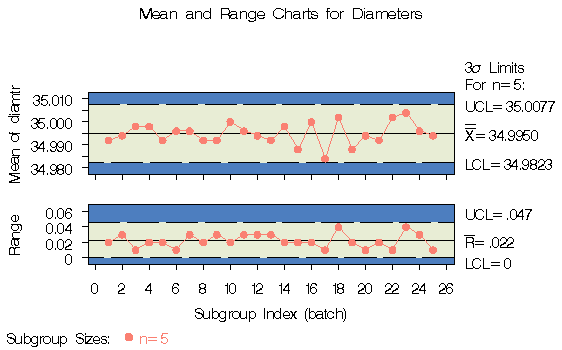Chapter Contents
Previous
Next
|
Chapter Contents |
Previous |
Next |
| XRCHART Statement |
| See SHWXR1 in the SAS/QC Sample Library |
In the manufacture of silicon wafers, batches of five wafers are sampled, and their diameters are measured in millimeters. The following statements create a SAS data set named WAFERS, which contains the measurements for 25 batches:
data wafers;
input batch @;
do i=1 to 5;
input diamtr @;
output;
end;
drop i;
datalines;
1 35.00 34.99 34.99 34.98 35.00
2 35.01 34.99 34.99 34.98 35.00
3 34.99 35.00 35.00 35.00 35.00
4 35.01 35.00 34.99 34.99 35.00
5 35.00 34.99 34.98 34.99 35.00
6 34.99 34.99 35.00 35.00 35.00
7 35.01 34.98 35.00 35.00 34.99
8 35.00 35.00 34.99 34.98 34.99
9 34.99 34.98 34.98 35.01 35.00
10 34.99 35.00 35.01 34.99 35.01
11 35.01 35.00 35.00 34.98 34.99
12 34.99 34.99 35.00 34.98 35.01
13 35.01 34.99 34.98 34.99 34.99
14 35.00 35.00 34.99 35.01 34.99
15 34.98 34.99 34.99 34.98 35.00
16 34.99 35.00 35.00 35.01 35.00
17 34.98 34.98 34.99 34.99 34.98
18 35.01 35.02 35.00 34.98 35.00
19 34.99 34.98 35.00 34.99 34.98
20 34.99 35.00 35.00 34.99 34.99
21 35.00 34.99 34.99 34.98 35.00
22 35.00 35.00 35.01 35.00 35.00
23 35.02 35.00 34.98 35.02 35.00
24 35.00 35.00 34.99 35.01 34.98
25 34.99 34.99 34.99 35.00 35.00
;
The following statements use the PRINT procedure to list the data set WAFERS. The listing is shown in Figure 43.1.
title 'The Data Set WAFERS'; proc print data=wafers noobs; run;
The data set WAFERS is said to be in "strung-out" form since each observation contains the batch number and diameter measurement for a single wafer. The first five observations contain the diameters for the first batch, the second five observations contain the diameters for the second batch, and so on. Because the variable BATCH classifies the observations into rational subgroups, it is referred to as the subgroup-variable. The variable DIAMTR contains the wafer diameter measurements and is referred to as the process variable (or process for short).
You can use ![]() and R charts to determine whether the
manufacturing process is in control. The following statements create
the
and R charts to determine whether the
manufacturing process is in control. The following statements create
the ![]() and R charts shown in Figure 43.2:
and R charts shown in Figure 43.2:
title 'Mean and Range Charts for Diameters';
symbol v=dot c=salmon;
proc shewhart data=wafers;
xrchart diamtr*batch / cframe = bigb
cinfill = ywh
cconnect = salmon
coutfill = yellow;
run;
The input data set is specified with the DATA= option in the PROC SHEWHART statement.
If you use a graphics device, the SYMBOL statement specifies the symbol to plot the points. For more information on the SYMBOL statement, refer to SAS/GRAPH Software: Reference.

|
Each point on the ![]() chart represents the
average (mean) of the measurements for a particular batch. For
instance, the mean plotted for the first batch is
chart represents the
average (mean) of the measurements for a particular batch. For
instance, the mean plotted for the first batch is
By default, the control limits shown are ![]() limits estimated
from the data; the formulas for the limits are given in Table 43.22.
You can also read control
limits from an input data set; see "Reading Preestablished Control Limits"
.
limits estimated
from the data; the formulas for the limits are given in Table 43.22.
You can also read control
limits from an input data set; see "Reading Preestablished Control Limits"
.
Since all the points lie within the control limits, it can be concluded that the process is in statistical control. For computational details, see "Constructing Charts for Means and Ranges" . For more details on reading raw data, see "DATA= Data Set" .
|
Chapter Contents |
Previous |
Next |
Top |
Copyright © 1999 by SAS Institute Inc., Cary, NC, USA. All rights reserved.